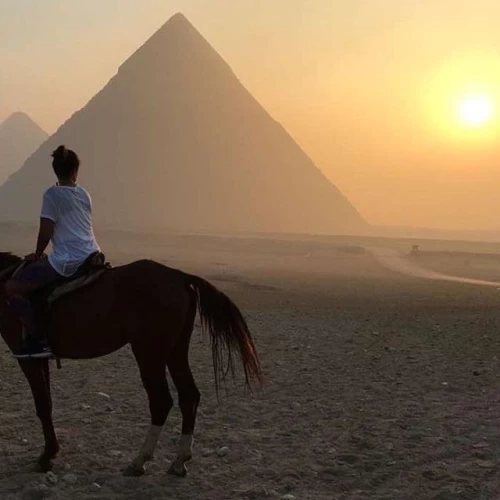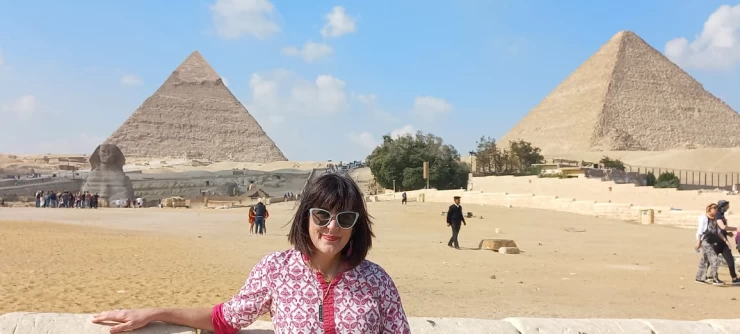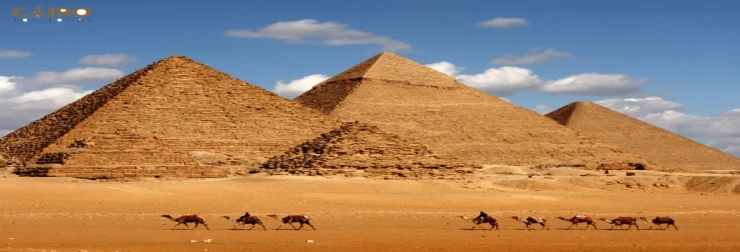Djoser的阶梯金字塔:埃及的开创性纪念碑
Djoser阶梯金字塔位于开罗郊区广阔的Saqqara,确实是埃及拥有的最强大但最古老的建筑之一。 通常被视为第一个实施大规模石材建造技术的结构,这座纪念性建筑可以说是古埃及金字塔建造时代的先锋。 这座神秘的建筑建于4600多年前,它的形状、故事和用法多种多样,至今仍然存在,并激励着考古学家、历史学家和游客。
历史背景及意义
阶梯金字塔,也被称为Djoser金字塔,建于公元前27世纪,在法老Djoser的统治下,他是埃及第三王朝的第二任君主。 乔瑟是一位进步的国王,他想要的不仅仅是使徒式的垂直坟墓--马斯塔巴斯--他是一个为其他法老创造的平顶墓设计的人,包括他的台阶。 他把这个项目委托给了他最信任的建筑师伊姆霍特普,他的历史会记住比建筑更伟大的事情。
伊姆霍特普,谁是建筑师提前他的时间和大祭司,渴望建立一个纪念碑,不仅是宏伟的法老眼中,但也将看到一个安全的航班奥西里斯。 为了实现这一目标,他发明了一种新的建筑设计,即阶梯金字塔,通过垂直堆叠六个尺寸越来越小的嵌套桅杆。 这座伟大的建筑不仅提升了乔瑟在死亡中的地位,而且永远改变了古埃及的建筑景观。
建筑奇迹:设计与建造
阶梯金字塔的高度约为62米(203英尺),是当时最高的结构。 Imhotep通过用石头建造金字塔而不是以前使用的泥砖,在建筑方面开创了新的趋势。 金字塔由六个层次或台阶组成,每个层次都向结构的顶峰上升,形成一个楼梯,被认为有助于国王的精神升天。
金字塔建筑群相当宽敞,占地约15公顷(37英亩),周围环绕着石灰岩墙,有14个假门和一个真门。 这个巧妙的设计具有象征和功能价值,因为它将法老的埋葬地点笼罩在神秘的光环中,并使他免受任何入侵者的侵害。 一旦进入围栏,人们可以找到几十个不同的建筑,如寺庙和庭院以及南墓,所有这些都是为了帮助已故的国王到达另一个世界以及服务宗教习俗。
令人印象深刻的地下隧道构成了阶梯金字塔综合体的一个特殊方面。 这些金库绵延5.7公里(3.5英里),拥有超过40,000个石罐,上面刻有Djoser之前其他国王的名字。 这些隧道布置的艰苦细节充分说明了古埃及人关于保护国王宝藏的想法。
伊姆霍特普:金字塔背后的天才
Imhotep,谁想出了阶梯金字塔的概念,是一个文艺复兴时期的人在几个领域,包括建筑,医学和宗教资格。 由于他参与建造阶梯金字塔,他获得了很多名声和尊重。 他是如此有影响力,以至于在他去世一个多世纪后,他被视为医学和治疗艺术之神。 他使用石头进行建筑的创新方式为之后的巨大金字塔(如吉萨大金字塔)让路。
Imhotep对阶梯金字塔建筑群的设计也显示了他对宗教工程的掌握程度。 金字塔的表面台阶结构代表了法老们升向神的象征,而内部的庭院和寺庙则代表了古埃及社会仪式的文化方面。 这种平衡功能设计和祭坛设计需求的能力,设想精神的大规模转化力量重申了他作为历史上最好的建筑师之一的地位。
宗教和文化的重要性
阶梯金字塔是神圣的象征,因为它既是一座坟墓,在这种情况下,也是通往生命另一个维度的大门。 法老被认为是能够与众神交往的人,因此被认为是神圣的。 与此相关,Djoser建造了阶梯金字塔,以保护他的神圣地位,并确保他的精神安全地穿越到其他存在的层面。
金字塔复杂结构的过程是准确的,因为它显示了基本方向,并包含与大法老的运输相关的元素。 南院是一个没有任何封闭内墙的大区域,很可能是在期待Heb-sed庆祝活动时扩大的,这是一种赋予国王合法性并拼写他的统治权的仪式。 这是一个机会,让乔瑟确定自己仍然生活和健康,即使在他被埋葬之后。
此外,其他封闭的小教堂和寺庙也是为祭司建造的,他们负责为国王Djoser的精神进行日常仪式,并为他的永恒之旅提供食物。 这种以这种方式崇拜死者的做法强调了生命,死亡和重生的无休止的循环,就像古埃及人的情况一样,古埃及人是他们生活方式的特征。
金字塔对未来建筑的影响
Djoser的阶梯金字塔为新一代金字塔奠定了基础,这些金字塔表面光滑,主导了古埃及建筑。 乔瑟纪念碑的成功带来了以下法老,他们委托越来越大的金字塔,从而产生了吉萨金字塔。
阶梯金字塔做了一些改进,这些改进后来在金字塔复合体的设计中是典型的。 其中许多建筑元素-采石,地下室墓室和结构的巨大规模-是建筑金字塔发展的先驱因素。 Djoser的阶梯金字塔可能是Sneferu,Khufu等人如此巨大的金字塔的主要原因。 是建造的。
重新发现和修复工作
对于许多代人来说,阶梯金字塔仍然是古埃及人建筑成就的象征,但随着时间的推移,它经历了很多侵蚀。 从1900年开始,一位名叫塞西尔*弗斯(Cecil Firth)的英国考古学家前往萨卡拉(Saqqara)并开始挖掘工作,这导致发现了金字塔建筑群中的大部分结构。 多年来,其他一些挖掘机也设法在这个非凡的结构上做了更多的工作。
然而,最近已经进行了修复工作,以恢复后代的阶梯金字塔。 这项广泛的工作除其他外涉及稳定内部分庭和重建外墙。 这些项目的目标是尽可能少地在建筑物的原始目的上妥协,并允许这座具有里程碑意义的建筑对该国的文化和历史进行更多年的见证。
今天参观阶梯金字塔
目前,参观Djoser阶梯金字塔的游客不仅可以欣赏结构本身,还可以欣赏整个建筑群,这也揭示了古埃及艺术和宗教的元素。 进入石门,漫步在开放的部分,人们几乎可以感受到一个由国王主导的过去时代的存在和永恒的建筑的形成。
尽管如此,萨卡拉的阶梯金字塔也是每个旅行者,每个历史学家和每个古埃及不朽文明的崇拜者的顶级景点之一。 它是法老乔瑟的梦想的纪念碑,也是被称为伊姆霍特普的天才的纪念碑,即使在它存在了4600年之后,人类仍然期待着这个奇迹。
Djoser的阶梯金字塔主要是作为坟墓建造的,也是法老Djoser神圣地位的不朽象征,服务于宗教和政治目的。 这里有一个更仔细的了解它为什么被建造以及它代表了什么:
1. 来世的皇家陵墓
来世被表示为一个重要的组成部分,而不是生命的终结,古埃及人认为它是有效的。 法老们被奉为地球之神,他们被埋葬在巨大的坟墓里,以保护他们的身体形态,并在他们死后保护他们的灵魂。 阶梯金字塔是为乔瑟的坟墓而建造的,以保存他的遗体和物品,并帮助他进入一个不朽的状态。 建筑的浩瀚和它是由坚实的岩石组成的事实代表了乔瑟的意义和他在形而上学世界的持久存在。
2. 神圣王权和权力的象征
法老不仅是政治家,而且他们是神王,相信与神有特殊的联系。 当Djoser建造第一座金字塔时,它是为了宣告他的敬虔,并永远保存他的记忆。 阶梯金字塔高耸的结构总是提醒Djoser的统治和神圣的权威,并强调他作为众神和社会的连接器的角色。
3. 宗教和文化意义
金字塔的形式和整个建筑群是由埃及宗教创造的。 在建筑物本身的背景下,这种被理解为梯田的外观代表了通往天堂的楼梯,希望Djoser的精神能够进入众神。 整个寺庙和建筑群内的开放区域都是为了进行特定的会议,以庆祝已故皇帝的死亡之旅和他与众神的逗留。
此外,该中心还容纳了旨在国王复兴的"Heb sed"仪式的元素。 虽然庆祝活动在法老统治时期很常见,以巩固他的地位,但它也与超越有关,因为这意味着Djoser永远不会失去控制精神领域的活力。
4. 建筑与遗产的创新
阶梯金字塔建筑彻底改变了埃及的埋葬结构,将它们放在金字塔上,而不是通常的方法,即矩形的mastaba墓葬。 Djoser还订购了这座创新建筑,不仅是为了他自己,也是为了展示他的统治的创造性和至高无上性。 通过创建一个前所未有的规模和复杂性结构,Djoser为埃及国家及其人民做出了重大贡献,这将超越时间和空间,加强酋长崇高地位和权力的宏伟概念。
总之,阶梯金字塔的设计是作为一个神圣的休息场所,这将是法老Djoser神圣统治的永恒标志,并作为建筑设计的突破,引导所有金字塔遵循。 通过这个令人敬畏的结构,Djoser希望被铭记为上帝,并为自己创造一个持久的遗产,这将是通过时间的沙子。
Located in the vast expanses of Saqqara in the outer suburb of Cairo, the Step Pyramid of Djoser is indeed one of the strongest, yet most ancient, structures that Egypt boasts about. Often regarded as the first structure to implement large-scale stone construction techniques, this monumental building can be said to have spearheaded the era of pyramid construction in ancient Egypt. Built over 4600 years ago, the mysterious construction with a wide array of shapes, stories, and usages still exists and inspires archeologists, historians, and tourists to this day.
Historical background and significance
The Step Pyramid, otherwise referred to as the Pyramid of Djoser, was constructed in the 27th century BCE under the reign of the Pharaoh Djoser, who was the second monarch of Egypt's Third Dynasty. Djoser was a progressive king who wanted something more than apostolic vertical graves—mastabas—that man who is into a flat-topped tomb design created for a range of other pharaohs, including his steps. He commissioned the project to his most trusted architect, Imhotep, whom history would remember for far greater things than mere architecture.
Imhotep, who was an architect ahead of his time and the high priest, aspired to build a monument that was not only grand in the eyes of the Pharaoh but would also see a safe flight to Osiris. To achieve this, he invented a new architectural design, which was known as a step pyramid, by vertically stacking six nesting mastabas of increasingly smaller size. This great edifice not only served to elevate the status of Djoser in death but also transformed the architectural landscape of ancient Egypt forever.
The Step Pyramid measures around 62 meters (203 feet) in height, and it was the highest structure back then. Imhotep set a new trend in construction by building the pyramid with stone instead of mudbrick, which was used before. The pyramid is made up of six levels, or steps, each of which rises toward the peak of the structure, forming a staircase that is believed to help the king’s spirit ascend to heaven.
The pyramid complex is quite spacious, covering about 15 hectares (37 acres) and surrounded by a limestone wall with 14 false doors and one real door. This ingenious design had both symbolic and functional value, as it shrouded the pharaoh’s burial place in an aura of mystery and secured him from any invaders. Once inside the enclosure, one can find dozens of different buildings, such as temples and courtyards as well as the South Tomb, all of which are meant to help the deceased king reach the other world as well as serve religious practices.
Impressive underground tunnels form one of the exceptional aspects of the Step Pyramid complex. The vast stretch of 5.7 km (3.5 miles) of these vaults has more than 40, 000 stone jars engraved with the names of other kings before Djoser. The painstaking detail in the arrangement of these tunnels speaks volumes about the ideas of the ancient Egyptians concerning the protection of the treasures of the king for all time.
Imhotep, who came up with the concept of the Step Pyramid, was a Renaissance man qualified in several fields, including architecture, medicine, and religion. Because of his involvement in building the Step Pyramid, he received a lot of fame and respect. He was so influential that he was treated like a god of medical and healing arts more than a century after his death. His innovative way of using stones for construction made way for the enormous pyramids that would come after, such as the Great Pyramid of Giza.
Imhotep's design for the Step Pyramid complex also shows how much he grasps engineering with religion. The superficial step structure of pyramids represents a symbol of ascending toward the gods for the pharaohs, while the inner courtyards and temples are a representation of the cultural aspects of ancient Egyptian society rituals. This ability to balance the need for functional design and altar design envisioning the mass-transforming power of spirits reaffirms his place as one of the best architects in history.
Religious and cultural importance
Step Pyramid is a representation of sacredness in the sense that it is both a tomb and, in this case, a door to another dimension of life. The pharaohs were believed to be the people who could mingle with the gods and, thus, were considered divine. In connection with this, Djoser built the Step Pyramid to protect his divine status as well as ensure that his spirit would traverse safely into other planes of existence.
The course of the pyramid complex construction is accurate in that it shows cardinal directions and contains elements associated with the transport of the great pharaohs. The South Court, which is a large region devoid of any enclosing interior wall, was most likely enlarged in anticipation of the Heb-Sed celebration, which was a ritual that granted legitimacy to the king and spelled his right to rule. This was an opportunity for Djoser to ascertain himself as still living and well, even after he had been buried.
Furthermore, the other enclosing chapels and temples were also built for the priests, who were responsible for conducting the daily ceremonies to the spirit of Djoser, the king, and feeding him for his eternal journey. Such a practice of worshipping the dead in this manner emphasized the unending cycle of life, death, and rebirth, as was the case with the ancient Egyptians, which characterized their way of life.
The Djoser's Step Pyramid laid the foundations for a new generation of pyramids with smooth surfaces that dominated ancient Egyptian architecture. The success of Djoser’s monument brought on the following pharaohs, who commissioned larger and larger pyramids, which resulted in the Giza pyramids.
The Step Pyramid made a few improvements that would later be typical in the design of pyramid complexes. Many of these construction elements—stone quarrying, basement burial chambers, and the giant scale of the structure—were factors that pioneered the development of building pyramids. Djoser’s Step Pyramid is probably the main reason why such enormous pyramids as those of Sneferu, Khufu et al. were constructed.
For many generations, the Step Pyramid remained the symbol of the architectural accomplishment of the ancient Egyptians, but with time, it underwent much erosion. Starting from the year 1900, one British archeologist by the name of Cecil Firth made his way to Saqqara and commenced excavation works, which led to the discovery of most of the structures in the pyramid complex. Over the years, some other excavators have also managed to do a little more work at this remarkable structure.
Recently, however, restoration work has been carried out to restore the Step Pyramid for posterity. The extensive work involves, among other things, the stabilization of the internal chambers and the reconstruction of the outer walls. Such projects thankfully aim to compromise as little as possible on the original purpose of the building and allow this landmark building to testify for even more years about the culture and history of the country.
Visiting the Step Pyramid Today
Currently, tourists visiting Djoser’s Step Pyramid can enjoy not just the structure itself but the entire complex, which also reveals the elements of ancient Egyptian art and religion. Entering through the stone doors and strolling around the open sections, one can almost feel the presence of a bygone era dominated by Kings and the making of everlasting structures.
Nevertheless, Saqqara’s Step Pyramid is also one of the top places to see for every traveler, every historian, and every admirer of the undying civilization of Ancient Egypt. It is a monument of Pharaoh Djoser’s dreams as well as of the genius called Imhotep, the wonder that mankind still looks up to even after 4600 years of its existence.



















